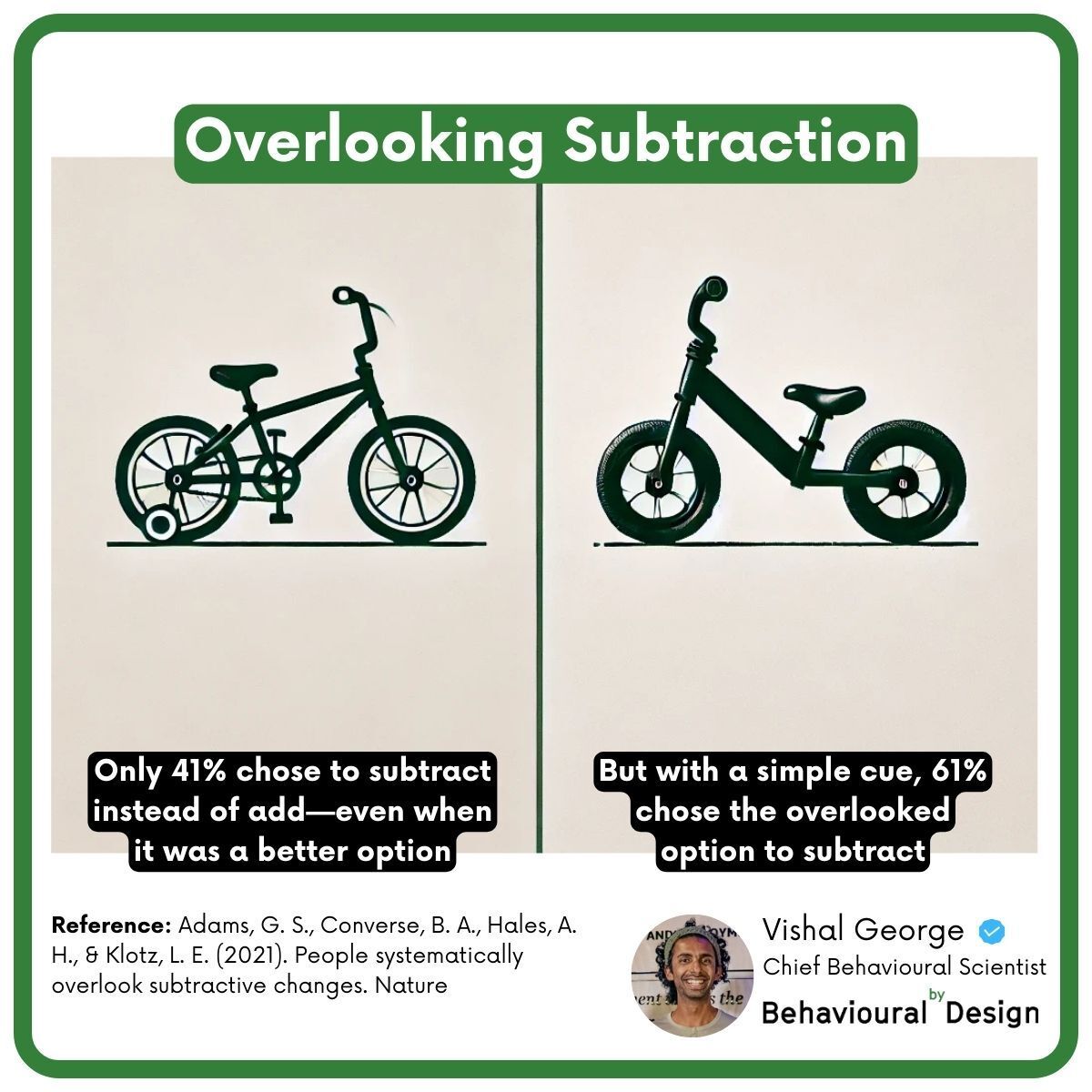TL;DR: People overlook subtraction, even when it’s the better choice—only 41% subtracted instead of adding. But with a simple nudge, 61% embraced subtraction.
Subtraction is the act of getting to less, but it is not the same as doing less. In fact, getting to less often means doing, or at least thinking, more.
🚲 Balance bike case-study: Watching a 2-year-old on a pedal-free balance bike makes many of us wish it existed when we were kids. Decades passed before someone thought to remove the pedals instead of adding stabilisers.
🎓 Researchers
— Gabrielle S. Adams, Associate Professor of Public Policy, University of Virginia
— Benjamin A. Converse, Associate Professor of Public Policy, University of Virginia
— Andrew H. Hales, Assistant Professor of Psychology, University of Virginia
— Leidy E. Klotz, Professor of Engineering, University of Virginia
Who is this for?
Product & Service Designers, Public Sector Leaders, Marketing Teams, Communications Experts, UX Researchers, Strategy Planners, and anyone tackling behaviour change who can benefit from the science of subtraction.

📚 The Evidence
Researchers explored how people approach problem-solving, when faced with options to add or remove elements. Their findings reveal that people tend to overlook subtraction as a strategy, even though removing elements can sometimes provide better results.
Article: Adams, G. S., Converse, B. A., Hales, A. H., & Klotz, L. E. (2021). People systematically overlook subtractive changes. Nature, 592, 258–261.
Read the abstract (full paper paywalled) - DOI: 10.1038/s41586-021-03380-y
📊 Key Results
In one of their experiments involving Lego blocks, participants were tasked with stabilising a structure. The experimenter said to all participants, “You will earn one dollar if you successfully complete this task. Each piece that you add costs ten cents.” Participants randomly assigned to the ‘Subtraction-cue’ group heard one more instruction from the experimenter: “but removing pieces is free and costs nothing.”
No-cue group: Only 41% chose to remove blocks to support the structure even though this was the most effective option.
Subtraction-cue group: When given the hint to consider subtraction, 61% chose to remove blocks, highlighting how a subtle nudge can bring our attention to subtraction as a viable strategy.
👉🏾 Vishal’s Evidence-Based Strategy
I. Encourage a subtraction mindset: Remind teams to consider removing features when designing new products, services and solutions. In digital platforms, removing options can create a better user experience and reduce choice overload.
II. Reduce sludge: Subtract unnecessary steps to help people achieve their desired outcomes. A financial service offering a 'set-and-forget' savings option can reduce friction, making automatic savings easy and effortless.
III. Boost engagement: Break down information into simple steps or three concise bullet points to enable action. For policy, use clear, jargon-free messaging can enhance understanding and improve public engagement.
🧪 Footnote on experimentation
Evidence evolves over time and rarely works across all contexts—start with a small experiment to find out what works for your specific challenge and audience.
P.S. You can also apply for our online masterclass, including two personalised coaching sessions, to learn how to apply our behavioural science tools.